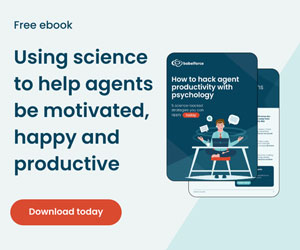In this blog, Enghouse look into the top eight AI capabilities you may want to check for in your current contact centre solution – or consider switching to a provider that offers them.
Remember the movie ‘Her,’ in which an advanced AI named Samantha interacts with the protagonist in personalized and emotionally intelligent ways?
This character resembles a highly intuitive and responsive customer service agent, illustrating just how deeply AI has infiltrated this field.
Once consigned to science fiction, AI is now playing a critical role in customer service.
Recent findings from Deloitte revealed a striking 14% productivity boost among contact centre agents using conversational AI, with the most significant improvements noted among newcomers and less skilled workers.
Meanwhile, Gartner forecasts that by 2025, a staggering 80% of customer service operations will leverage generative AI to enhance both agent efficiency and the overall customer experience.
Given AI’s transformative potential, it won’t be an exaggeration to say that businesses with AI-powered contact centre solutions will outperform their peers.
1. AI-Powered Virtual Agents to Free Up Human Resources
Virtual agents are revolutionizing customer service as the first point of contact. They interact dynamically, using NLP to handle inquiries across multiple channels – providing immediate answers and taking care of routine tasks 24/7.
What sets these agents apart from your typical chatbots is their ability to operate with the nuance and attentiveness of a human.
Take virtual agents for example. They seamlessly blend with human teams to cover every platform, freeing up human agents to tackle the trickier issues. Using natural language dialog, they pull real-time data from websites and other reliable sources.
Plus, they automate critical business processes—from balance checks to updating delivery details—boosting efficiency and accelerating workflow.
2. Intelligent Routing to Reduce Wait Times and Improve First Call Resolution Rates
AI-powered routing systems at contact centres intelligently automate the distribution of incoming inquiries to the most appropriate agent based on factors like skillset, workload, and customer profile.
Some platforms take this intelligent routing a step further by offering a user-friendly graphical interface to create and manage advanced routing strategies visually, like a block diagram.
This tool lets you tailor the call flow based on dynamic conditions such as customer value and agent status.
Customer value is assessed using inputs from an interactive menu or external systems, which provide real-time context on the customer.
Additionally, the routing adjusts based on agent availability, service levels, and queue times, varying with different times of the day.
This method not only improves customer experience by providing timely and effective responses but also reduces handling costs and wait times, leading to better first-contact resolution rates and overall customer satisfaction.
3. AI-Enabled Summarization to Elevate Efficiency and Service Quality
AI-enabled summarization transforms lengthy conversations into concise, clear summaries. This saves time at the start and end of calls, allowing agents to quickly review previous interactions and streamline post-call wrap-ups.
AI-enabled summarization uses natural language processing (NLP) to automatically create accurate summaries after each call.
The AI understands key aspects of the conversation, highlights important elements, and identifies the next actions.
This reduces the time and manual effort agents typically spend on these tasks, freeing them up for the next engagement.
By condensing interactions into up to four sentences, AI-enabled summarization reduces overall handle time (AHT) and helps agents quickly grasp essential details.
This efficiency eliminates oversights and inaccuracies in manual summaries, reduces queue wait times, improves service levels, and increases customer satisfaction.
4. Automated Agent Evaluation to Improve Agent Development
AI-enabled agent evaluation refers to using AI to assess the performance of contact centre agents during their interactions with customers and post-calls with recordings.
This technology analyzes live calls, call recordings, chats, emails, and other interactions to identify strengths and weaknesses.
Traditionally, supervisors spot-check agent calls to evaluate performance, which can be biased and time-consuming.
Automated Agent Evaluation uses AI to analyze all interactions across different channels (voice, email, chat, etc.).
Moreover, a customizable scorecard feature allows managers to tailor evaluation criteria to their specific business needs.
This adaptability makes assessments relevant and aligned with organizational goals, ensuring consistency and fairness.
With AI-enabled evaluations, supervisors can easily pinpoint areas for improvement and target their coaching efforts effectively.
This approach not only enhances agent performance and customer service quality but also reduces QA costs and overhead through automation.
5. Insights Into the Voice of the Customer (VoC)
Every interaction with a business can provide insights into customer satisfaction levels and pinpoint potential issues, but extracting those insights can be a challenge.
AI enhances this process by analyzing recorded interactions like voice calls, emails, chats, and social messages to uncover the Voice of the Customer (VoC).
Surveys can further enrich these insights by gathering specific customer feedback. Combining survey data (including free-text responses) with insights from digital interactions provides a comprehensive understanding of customer expectations.
AI Insights uses semantic technology to explore the context and nuances of customer feedback, uncovering emotions such as satisfaction, fear, disappointment, and sarcasm. This enables organizations to tailor strategies for better customer experiences.
By identifying key themes, trends, and concerns, it offers valuable feedback on logistical, operational, and product-related problems.
This proactive approach helps resolve critical issues before they escalate, boosting customer loyalty, reducing churn, and enhancing upselling and cross-selling opportunities.
6. AI-Driven Surveys to Uncover the Voice of the Employee (VoE)
Empowering agents is crucial for businesses to deliver better service, retain employees, and improve customer satisfaction.
The first step is to listen and understand their needs, identifying specific concerns and motivations to address issues effectively.
Traditional surveys can be time-consuming and often have low response rates. AI-driven surveys provide a smarter solution by tailoring questions based on previous responses, ensuring each interaction is relevant and engaging. This approach yields higher response rates and more precise data.
AI is further helpful in analyzing the survey responses, for instance, extracting actionable insights from VoE initiatives and internal surveys with over 95% accuracy.
By leveraging a combination of machine learning, Natural Language Processing (NLP), and industry-specific jargon, it eliminates the need for extra processing or validation.
7. Automatic Translation for Effortless Multilingual Chat Communication
AI-enabled chat translation allows customers to communicate in their preferred language with any available agent.
When customers start a web chat, AI recognizes and translates the messages, presenting them to agents in their preferred language.
Agents reply in their language, and AI translates responses to the customer’s language. This seamless interaction ensures smooth communication and enhances the customer experience, leading to greater satisfaction.
Real-time chat translation technology helps global companies like Hitachi Energy provide 24/7 multilingual support.
With centres in the US, Mexico, India, Poland, and China, Hitachi handles queries in 18 languages, even during off-hours, eliminating the need for additional language services and boosting efficiency and ROI.
AI translation ensures agents can assist customers in their native language, regardless of the agent’s language skills. This broadens the customer base and improves service quality for all callers.
8. Live Speech Monitoring to Improve Customer Conversations and Quality Assurance
Real-time coaching evaluates customer calls as they happen, providing immediate feedback to agents. This helps agents manage stress, maintain a calm tone, and follow company scripts, ensuring professional call handling even under pressure.
Real-time coaching uses AI to assess live calls. It goes beyond listening by analyzing stress, conflict, tone, volume, and speaking speed.
This AI-driven system offers instant guidance and reminds agents of key phrases to include in their conversations.
These on-screen reminders help agents stay focused and manage calls effectively. Additionally, calls can also be recorded for follow-up with managers.
This market-leading speech recognition technology supports multiple languages, including English, German, Italian, French, Spanish, and Turkish, with the potential for more.
This capability enhances quality assurance, agent training, and customer interaction optimization. The solution simplifies the supervisor’s role by automating monitoring and coaching, making it easier to support agents in real-time and ensure high-quality service.
Hopefully, this overview of AI capabilities has left you in awe of AI’s transformative potential for contact centres.
This blog post has been re-published by kind permission of Enghouse Interactive – View the Original Article
For more information about Enghouse Interactive - visit the Enghouse Interactive Website
Call Centre Helper is not responsible for the content of these guest blog posts. The opinions expressed in this article are those of the author, and do not necessarily reflect those of Call Centre Helper.
Author: Enghouse Interactive
Published On: 15th Jul 2024 - Last modified: 22nd Oct 2024
Read more about - Guest Blogs, Enghouse Interactive






 Enghouse Interactive delivers technology and expertise to help bring your customers closer to your business through its wide range of customer contact solutions.
Enghouse Interactive delivers technology and expertise to help bring your customers closer to your business through its wide range of customer contact solutions. 








